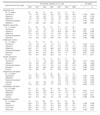Abstract
This study was performed to evaluate the prescribing pattern of antibiotics and the relationship between antibiotic use and antibiotic resistance in major nosocomial pathogens at a university hospital in Korea. Data on annual patient-days and annual consumption (defined daily dose (DDD)/1,000 patient-days) of all antibiotics from 2000 to 2006 were analyzed. The antibiotic resistance in major nosocomial pathogens was determined by disc diffusion or automated systems. Spearman's correlation coefficient was used to determine the relationship between antibiotic use and resistance. Increasing trend on incidences of Klebsiella pneumoniae causing nosocomial bloodstream infections was noted from 2000 to 2006 (r=0.786, p=0.036). Even though the annual patient-days of the hospital did not change (r=−0.107, p=0.819), the annual usage of antibiotics significantly increased from 2000 to 2006 (r=0.929, p=0.003). A significant stepwise increase in consumption (r>0.72 and p<0.05) was found for several broad-spectrum antibiotics such as ceftriaxone, piperacillin/tazobactam, imipenem, and vancomycin. The rise in piperacillin/tazobactam-resistant Serratia marcenscens (r=0.893, p=0.007) and piperacillin/tazobactam-resistant Pseudomonas aeruginosa (r=1.000, p=0.000) was significantly correlated with increased consumption of piperacillin/tazobactam respectively. Increased ciprofloxacin-resistant S. marcescens was significantly associated with increased usage of ciprofloxacin (r=0.919, p=0.003). This study demonstrated the significant changes in antibiotic use and positive relationship between antibiotic use and antibiotic resistance in several nosocomial pathogens. Continuous surveillance of antibiotic use is needed to encourage appropriate use of antibiotics and to reduce antibiotics resistance.
Figures and Tables
Fig. 1
Incidence (episodes per 10,000 patient-days) of nosocomial bloodstream infection caused by major nosocomial pathogens from patients treated at Chonnam National University Hospital in Korea from 2000~2006.

Fig. 2
Annual consumption and proportional use of several representative classes of antimicrobial agents at Chonnam National University Hospital in Korea, 2000~2006. BLBLI, β-lactam /β-lactamase inhibitor.

Table 1
Trends of resistance rates among major nosocomial pathogens causing nosocomial bloodstream infections at Chonnam National University Hospital, 2000~2006

References
1. Cosgrove SE. The relationship between antimicrobial resistance and patient outcomes, mortality, length of hospital stay, and health care costs. Clin Infect Dis. 2006. 42:Suppl 2. S82–S89.

2. Song JH, Jung SI, Ko KS, Kim NY, Son JS, Chang HH, et al. High prevalence of antimicrobial resistance among clinical Streptococcus pneumoniae isolates in Asia (an ANSORP study). Antimicrob Agents Chemother. 2004. 48:2101–2107.

3. WHO. WHO Global Strategy for Containment of antimicrobial resistance. 2001. WHO/CDS/CSR/DRS/2001/2/EN.
4. WHO. Antibiotic resistance: synthesis of recommendations by expert policy group. 2001.
5. WHO. WHO collaborating centre for drug statistacs methodology. http://www.whocc.no/atcddd/.
6. Kim DS, Kim NS, Jang SM. The study for trend of national antibiotic consumption. Infect Chemother. 2006. 38:Suppl 1. S1–S28.
7. Jung SI, Park KH, Kwon KT, Ko KS, Oh WS, Chung DR, et al. Relationship between beta-lactam antimicrobial use and antimicrobial resistance in Klebsiella pneumoniae clinical isolates at 5 tertiary hospitals in Korea. Infect Chemother. 2007. 39:189–195.
8. Yoon YK, Kim MJ, Sohn JW, Park DW, Kim JY, Chun BC. Surveilance of antimicrobial use and antimicrobial resistance. Infect Chemother. 2008. 40:93–101.

9. Wisplinghoff H, Bischoff T, Tallent SM, Seifert H, Wenzel RP, Edmond MB. Nosocomial bloodstream infections in US hospitals: analysis of 24,179 cases from a prospective nationwide surveillance study. Clin Infect Dis. 2004. 39:309–317.

10. Lee KW, Kim YA, Park YJ, Lee HS, Kim MY, Kim EC, et al. Increasing prevalence of vancomycin-resistant Enterococci, and cefoxitin-, imipenem-, fluroquinolone-resistant gram-negative bacilli: a KONSAR study in 2002. Yonsei Med J. 2004. 45:598–608.

11. Lee HK, Kim CK, Lee J, Lee SH, Ahn JY, Hong SG, et al. Antimicrobial resistance of clinically important bacteria isolated from 12 hospitals in Korea in 2005 and 2006. Korean J Clin Microbiol. 2007. 10:59–69.
12. McGowan JE Jr, Tenover FC. Control of antimicrobial resistance in the health care system. Infect Dis Clin North Am. 1997. 11:297–311.

13. Du B, Chen D, Liu D, Long Y, Shi Y, Wang H, et al. Restriction of third-generation cephalosporin use decreases infection-related mortality. Crit Care Med. 2003. 31:1088–1093.

14. Shalit L, Low M, Levy E, Chowers M, Zimhony O, Riesenberg K, et al. Antibiotics use in 26 departments of internal medicine in 6 general hospitals in Israel: variablility and contributing factors. J Antimicrob Chemother. 2008. 62:196–204.

15. Monnet DL, MacKenzie FM, López-Lozano JM, Beyaert A, Camacho M, Wilson R, et al. Amtimicrobial drug use and methicillin-resistant Staphylococcus aureus, Aberdeen, 1996-2000. Emerg Infect Dis. 2004. 10:1432–1441.





 PDF
PDF ePub
ePub Citation
Citation Print
Print




 XML Download
XML Download